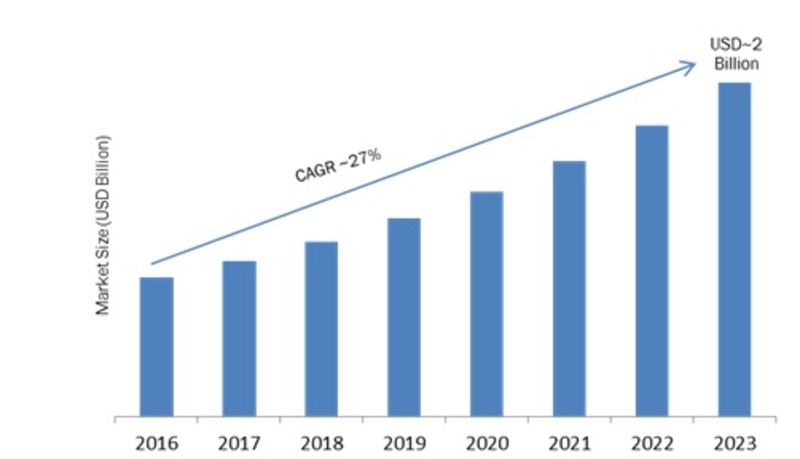Market Synopsis
The global self-learning neuromorphic chip market can touch an approximate valuation of USD 2 Billion by 2023, affirms Market Research Future (MRFR). Furthermore, a growth rate of 27% is expected to be achieved by the market between 2017 and 2023, which is the forecast period.
Market Boosters and Key Restraints
IBM is counted among the top players in the self-learning neuromorphic chip market, known for having designed a neuromorphic chip similar to the human brain. The chip works better with image recognition and has the ability to correctly categorize data far more efficiently in terms of energy as compared to traditional processor architectures. This chip finds applications such as IoT, mobile computing, autonomous cars, HPC and robotics.
Qualcomm is an up-coming vendor striving to make its presence felt in the Self-Learning Neuromorphic Chip Market. The company has developed a Zeroth neuromorphic chip program and is primarily focusing on researches to analyze its latest technology.
Sensing the opportunities arising from the advancements in disruptive technologies like Machine Learning (ML) and Artificial Intelligence (AI), several embedded system providers are now making efforts to develop brain chips. These chips will not only be processed quickly but will also respond just like a human brain, enabling the systems to act in a human way. Internet of things (IoT), smart sensors and data analytics are the significant applications for the self-learning neuromorphic chip market, since these chips are important parts of the hardware that are used for data mining, image recognition, and others.
Get Free Sample Copy of Self-Learning Neuromorphic Chip Market @ https://www.marketresearchfuture.com/sample_request/4365
Self-Learning Neuromorphic Chip Market Key Players:
The prominent players in the self-learning neuromorphic chip market are- IBM (U.S.), Qualcomm (U.S.), HRL Laboratories (U.S.), General Vision (U.S.), Numenta (U.S.), Hewlett-Packard (U.S.), Samsung Group (South Korea), Intel Corporation (U.S.), Applied Brain Research Inc. (U.S.), Brainchip Holdings Ltd. (U.S.) and others.
Market Segmentation
Application and vertical are the primary segments by which the global self-learning neuromorphic chip market has been extensively studied in the MRFR report.
The application segment has been split into image recognition, signal recognition, and data mining. The signal recognition market is expected to gain the highest traction in the coming years; the signal recognition technology finds widespread use in healthcare, commercial, automotive, consumer electronics, aerospace, and defense industries. Rising advancements in image recognition technology, as well as its application in a variety of applications like home automation, portable devices, digital health and robotics, also induce market growth.
According to the vertical segment, the market includes healthcare, power & energy, automotive, media and entertainment, aerospace and defense, smartphones, consumer electronics, and others. Between these, the medical along with automotive & transportation forms the largest portion of the market.
Regional Insight
North America, Asia Pacific (APAC), Europe, and the Rest of the World (RoW) are the primary markets for self-learning neuromorphic chip and have been extensively analyzed by MRFR experts in order to give a better understanding of the latest trends and growth opportunities.
North America is the prime market for self-learning neuromorphic chip, generating maximum revenue among all the regions. The concentration of renowned players and a huge market for image recognition benefits the regional market. Rising implementation of self-learning neuromorphic chip in different applications like consumer electronics, wearables, aerospace, medical, and others are also fueling the market growth. The region has noted a series of mergers, product launches and acquisitions that expand the market size significantly. Also, sizeable investments in research and development (R&D) in the field has led to the uncovering of new applications for self-learning neuromorphic chips, which works in favor of the market.
Access Full Report @ https://www.marketresearchfuture.com/reports/self-learning-neuromorphic-chip-market-4365
The APAC neuromorphic chip market is observing strong growth, thanks to the mounting demand for artificial intelligence, and the rising consumer preference for small-sized products that has resulted in the miniaturization of ICs. With the increasing popularity of smart technologies, smart sensors now enjoy high demand from end-user industries like electronics, medical and automotive in the region. Other opportunities in the market come in the form of the rising use of self-learning neuromorphic chips in the medical and military and defense sectors within the region.
About Market Research Future:
At Market Research Future (MRFR), we enable our customers to unravel the complexity of various industries through our Cooked Research Report (CRR), Half-Cooked Research Reports (HCRR), Raw Research Reports (3R), Continuous-Feed Research (CFR), and Market Research & Consulting Services.
Media Contact
Company Name: Market Research Future
Contact Person: Abhishek Sawant
Email: Send Email
Phone: +1 646 845 9312
Address:Market Research Future Office No. 528, Amanora Chambers Magarpatta Road, Hadapsar
City: Pune
State: Maharashtra
Country: India
Website: https://www.marketresearchfuture.com/reports/self-learning-neuromorphic-chip-market-4365

